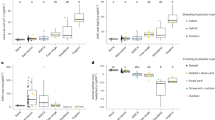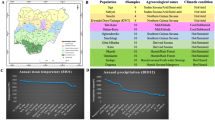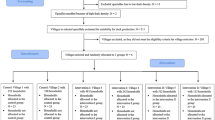Abstract
Village chickens are ubiquitous in smallholder farming systems, contributing to household, local and national economies under diverse environmental, economic and cultural settings. However, they are raised in challenging environments where productivity is low while mortality is high. There is much interest in utilizing indigenous genetic resources to produce a chicken that is resilient to its environment, while at the same time providing the basis of an economically sustainable enterprise. Globally, however, a wide variety of interventions have so far proved unable to deliver sustainable improvements. Here we show that regional differences in trait preferences and parasite burden are associated with distinct chicken gene pools, probably in response to interactions between natural and human-driven (economic and social) selection pressures. Drivers of regional differences include marketing opportunities, cultural preferences, agro-ecologies and parasite populations, and are evident in system adaptations, such as management practices, population dynamics and bird genotypes. Our results provide sound multidisciplinary evidence to support previous observations that sustainable poultry development interventions for smallholder farmers, including breeding programmes, should be locally tailored and designed for flexible implementation.
This is a preview of subscription content, access via your institution
Access options
Access Nature and 54 other Nature Portfolio journals
Get Nature+, our best-value online-access subscription
$29.99 / 30 days
cancel any time
Subscribe to this journal
Receive 12 digital issues and online access to articles
$119.00 per year
only $9.92 per issue
Buy this article
- Purchase on Springer Link
- Instant access to full article PDF
Prices may be subject to local taxes which are calculated during checkout





Similar content being viewed by others
Data availability
The bioclimatic variables that used in this study are available from ‘WorldClim’ (http://www.worldclim.org/). The land cover variable data are available from the ‘Harmonized World Soil Database’ (http://webarchive.iiasa.ac.at/Research/LUC/External-World-soil-database/HTML/index.html?sb=1). All other data that support the findings of this study are available from the corresponding author upon reasonable request.
References
Mack, S., Hoffmann, D. & Otte, J. The contribution of poultry to rural development. Worlds Poultry Sci. J. 61, 7–14 (2005).
Alders, R. G. & Pym, R. A. E. Village poultry: still important to millions, eight thousand years after domestication. Worlds Poultry Sci. J. 65, 181–190 (2009).
Decision Tools for Family Poultry Development (FAO, 2014).
Bagnol, B. SADC Planning Workshop on Newcastle Disease Control in Village Chickens (eds R. G. Alders & P. Spradbrow) (Australian Centre for International Agricultural Research, 2000).
Ahlers, C. et al. Improving Village Chicken Production: a Manual for Fieldworkers and Trainers ACIAR Monograph No. 139 (Australian Centre for International Agricultural Research, 2009).
Dwinger, R. H. & Unger, H. in Improving Farmyard Poultry Production in Africa: Interventions and their Economic Assessment 1–9 (International Atomic Energy Agency, 2006).
Pica-Ciamarra, U. & Dhawan, M. A Rapid Rural Appraisal of the Family-Based Poultry Distribution Scheme of West Bengal, India Pro-Poor Livestock Policy Initiative (PPLPI) Research Report (FAO, 2009).
Sonaiya, E. B. Constraints to adoption and sustainability of improved practices in scavenging poultry systems. Family Poultry Commun. 21, 34–43 (2012).
Khobondo, J. O. et al. Genetic and nutrition development of indigenous chicken in Africa. Livestock Res. Rural Dev. 27, 122 (2015).
Saleque, M. A. & Mustafa, S. Landless women and poultry: the BRAC model in Bangladesh. In Livestock Feed Resources within Integrated Farming Systems (eds F. Dolberg & P. H. Petersen) 37–55 (FAO, 1996).
FAO Poultry in the 21st century: avian influenza and beyond. In Proc. Int. Poultry Conf. (eds O. Thieme & D. Pilling) (FAO, 2008).
Report on Livestock and Livestock Characteristics (Private Peasant Holdings) (Central Statistical Agency, 2010/2011).
Dessie, T. & Jobre, Y. A review of the importance and control of Newcastle disease in Ethiopia. Ethiop. Vet. J. 8, 71–81 (2004).
Poultry Sector Country Review (FAO, 2008).
Dinka, H., Chala, R., Dawo, F., Bekana, E. & Leta, S. Major constraints and health management of village poultry production in Rift Valley of Oromia, Ethiopia. Am. Eurasian J. Agric. Environ. Sci. 9, 529–533 (2010).
Mazengia, H., Bekele, S. T. & Negash, T. Incidence of infectious bursal disease in village chickens in two districts of Amhara Region, Northwest Ethiopia. Livestock Res. Rural Dev. 21, 214 (2009).
Dana, N., van der Waaij, L. H., Dessie, T. & van Arendonk, J. A. Production objectives and trait preferences of village poultry producers of Ethiopia: implications for designing breeding schemes utilizing indigenous chicken genetic resources. Trop. Anim. Health Prod. 42, 1519–1529 (2010).
Thompson, J. & Scoones, I. Addressing the dynamics of agri-food systems: an emerging agenda for social science research. Environ. Sci. Policy 12, 386–397 (2009).
Brown, B. J., Hanson, M. E., Liverman, D. M. & Merideth, R. W. Global sustainability: toward definition. Environ. Manag. 11, 713–719 (1987).
Gibson, R. B. Specification of Sustainability-Based Environmental Assessment Decision Criteria and Implications for Determining “Significance” in Environmental Assessment (Canadian Environmental Assessment Agency, 2001).
Fresco, L. O. Challenges for food system adaptation today and tomorrow. Environ. Sci. Policy 12, 378–385 (2009).
Desta, T. T. et al. Signature of artificial selection and ecological landscape on morphological structures of Ethiopian village chickens. Anim. Genet. Resour. 52, 17–29 (2013).
Mengesha, M. & Tsega, W. Phenotypic and genotypic characteristics of indigenous chickens in Ethiopia: a review. Afr. J. Agric. Res. 6, 5398–5404 (2011).
Imsland, F. et al. The rose-comb mutation in chickens constitutes a structural rearrangement causing both altered comb morphology and defective sperm motility. PLoS Genet. 8, e1002775 (2012).
Psifidi, A. et al. Genome-wide association studies of immune, disease and production traits in indigenous chicken ecotypes. Genet. Sel. Evol. 48, 74 (2016).
Bettridge, J. The Epidemiology and Ecology of Infectious Diseases in Ethiopian Village Chickens and the Role of Co-infection in Infection Risk. PhD thesis, Univ. Liverpool (2014).
Storck, H., Emana, B., Adenew, B., Borowiecki, A. & W/Hawariat, S. Farming Systems and Farm Management Practices of Smallholders in the Hararghe Highlands (Wissenschaftsverlag Vauk Kiel, Kiel, 1991).
Permin, A. & Hansen, J. W. Epidemiology, Diagnosis and Disease Control of Poultry Parasites (FAO, 1998).
Bishop, S. C. & Wooliams, J. A. On the genetic interpretation of disease data. PLoS ONE 5, e8940 (2010).
Bishop, S. C., Doeschl-Wilson, A. B. & Woolliams, J. A. Uses and implications of field disease data for livestock genomic and genetics studies. Front. Genet. 3, 114 (2012).
Hudson, P. J., Dobson, A. P. & Newborn, D. Prevention of population cycles by parasite removal. Science 282, 2256–2258 (1998).
Pavlidis, P., Živković, D., Stamatakis, A. & Alachiotis, N. SweeD: likelihood-based detection of selective sweeps in thousands of genomes. Mol. Biol. Evol. 30, 2224–2234 (2013).
Horns, F. & Hood, M. E. The evolution of disease resistance and tolerance in spatially structured populations. Ecol. Evol. 2, 1705–1711 (2012).
Queenan, K. et al. An appraisal of the indigenous chicken market in Tanzania and Zambia. Are the markets ready for improved outputs from village production systems? Livestock Res. Rural Dev. 28, 185 (2016).
Aklilu, H. A., Udo, H. M. J., Almekinders, C. J. M. & Van der Sijpp, A. J. How resource poor households value and access poultry: village poultry keeping in Tigray, Ethiopia. Agric. Syst. 96, 175–183 (2008).
Tadelle, D., Million, T., Alemu, Y. & Peters, K. J. Village chicken production systems in Ethiopia: 2. Use patterns and performance valuation and chicken products and socio-economic functions of chicken Livestock Res. Rural Dev. 15, 10 (2003).
Calloway, D. H. et al. Village Nutrition in Egypt, Kenya and Mexico: Looking Across the CRSP Projects (Univ. California, Berkeley, 1992).
Marangoni, F. et al. Role of poultry meat in a balanced diet aimed at maintaining health and wellbeing: an Italian consensus document. Food Nutr. Res. 59, 27606 (2015).
Halderman, M. The Political Economy of Pro-Poor Livestock Policy-making in Ethiopia. Pro-Poor Livestock Policy (PPLPI) Initiative Working Paper No. 19 (FAO, 2004).
Wondmeneh, E. et al. Village poultry production system: perception of farmers and simulation of impacts of interventions. Afr. J. Agric. Res. 11, 2075–2081 (2016).
Smallholder Poultry Production — Livelihoods, Food Security and Sociocultural Significance. Smallholder Poultry Production Paper No. 4 (FAO, 2010).
Vaarst, M., Steenfeldt, S. & Horsted, K. Sustainable development perspectives of poultry production. Worlds Poultry Sci. J. 71, 609–620 (2015).
Zussman, R. People in places. Qual. Sociol. 27, 351–363 (2004).
Timmermans, S. & Berg, M. Standardization in action: achieving local universality through medical protocols. Soc. Stud. Sci. 27, 273–305 (1997).
Seeds, Diversity and Development — Key Concepts (FAO, 2014).
Gregory, N. G. & Robins, J. K. A body condition scoring system for layer hens. New. Zeal. J. Agr. Res. 41, 555–559 (1998).
Clayton, D. H. & Drown, D. M. Critical evaluation of five methods for quantifying chewing lice (Insecta: Phthiraptera). J. Parasitol. 87, 1291–1300 (2001).
Bettridge, J. M. et al. Infection-interactions in Ethiopian village chickens. Prev. Vet. Med. 117, 358–366 (2014).
Luu, L. et al. Prevalence and molecular characterisation of Eimeria species in Ethiopian village chickens. BMC Vet. Res. 9, 208 (2013).
Lapage, G. Veterinary Parasitology (Oliver & Boyd, London, 1956).
Soulsby, E. J. L. Helminths, Arthropods and Protozoa of Domesticated Animals 7th edn (Bailliere & Tindall, London, 1982).
Smith, L. M. & Burgoyne, L. A. Collecting archiving and processing DNA form wildlife samples using FTA databasing paper. BMC Ecol. 4, 4 (2004).
Kranis, A. et al. Development of a high density 600K SNP genotyping array for chicken. BMC Genomics 14, 59 (2013).
Gregory, R. D. & Woolhouse, M. E. J. Quantification of parasite aggregation: a simulation study. Acta Trop. 54, 131–139 (1993).
Poulin, R. The disparity between observed and uniform distributions: a new look at parasite aggregation. Int. J. Parasitol. 23, 937–944 (1993).
Bates, D., Maechler, M., Bolker, B. & Walker, S. lme4: linear mixed-effects models using ‘Eigen’ and S4. J. Stat. Softw. 67, 1–48 (2015).
R Core Team R: A Language and Environment for Statistical Computing (R Foundation for Statistical Computing, Vienna, 2013); http://www.R-project.org
Peterson, A. T. Predicting species geographic distributions based on ecological niche modeling. Condor 103, 599–605 (2001).
Phillips, S. J., Anderson, R. P. & Schapire, R. E. Maximum entropy modeling of species geographic distributions. Ecol. Modell. 190, 231–259 (2006).
Hijmans, R. J., Cameron, S. E., Parra, J. L., Jones, P. G. & Jarvis, A. Very high resolution interpolated climate surfaces for global land areas. Int. J. Climatol. 25, 1965–1978 (2005).
Harmonized World Soil Database v.1.2 (FAO, 2012); http://www.fao.org/soils-portal/soil-survey/soil-maps-and-databases/harmonized-world-soil-database-v12/en/
Hijmans, R. J., Phillips, S., Leathwick, J. & Elith, J. Species Distribution Modeling R package v.1.1-4 (2017); https://cran.r-project.org/web/packages/dismo/index.html
Desta, T. T. Phenomic and Genomic Landscape of Ethiopian Village Chicken. PhD thesis, Univ. Nottingham (2015).
Gautier, M. & Vitalis, R. rehh: an R package to detect footprints of selection in genomewide SNP data from haplotype structure. Bioinformatics 28, 1176–1177 (2012).
Aulchenko, Y. S., Ripke, S., Isaacs, A. & van Duijn, C. M. GenABEL: an R library for genome-wide association analysis. Bioinformatics 23, 1294–1296 (2007).
Purcell, S. et al. PLINK: a tool set for whole-genome association and population-based linkage analyses. Am. J. Hum. Genet. 81, 559–575 (2007).
Zhou, X. & Stephens, M. Efficient multivariate linear mixed model algorithms for genome-wide association studies. Nat. Methods 11, 407–409 (2014).
Acknowledgements
We thank the Chicken Health for Development project team members and the farmers and development agents in the Jarso and Horro districts for their assistance; D. Hume and G. Banos for helpful comments on drafts of the manuscript; and the Biotechnology and Biological Sciences Research Council (BBSRC), the UK Department for International Development (DFID) and the Scottish Government for providing funding for the ‘Reducing the impact of infectious disease on poultry production in Ethiopia’ project under the Combating Infectious Diseases of Livestock for International Development (CIDLID) program (BB/H009396/1, BB/H009159/1 and BB/H009051/1). J.M.B., T.D. and O.H. are supported by CGIAR fund donors http://www.cgiar.org/our-funders/.
Author information
Authors and Affiliations
Contributions
R.M.C., O.H., P.W., P.K. and T.D. conceived and designed the research; J.M.B., Z.G.T., T.T.D. and P.K. undertook field sampling; A.P., T.T.D., P.K. and O.H. performed genomic analysis; J.M.B. and R.M.C. undertook statistical analysis of epidemiological data; Z.G.T. and R.M.C. undertook statistical analysis of socio-economic data; M.L.-J. performed ecological niche modelling; R.M.C., J.M.B., A.P. and O.H. wrote the paper with inputs from other authors.
Corresponding author
Ethics declarations
Competing interests
The authors declare no competing interests.
Additional information
Publisher’s note: Springer Nature remains neutral with regard to jurisdictional claims in published maps and institutional affiliations.
Supplementary information
Rights and permissions
About this article
Cite this article
Bettridge, J.M., Psifidi, A., Terfa, Z.G. et al. The role of local adaptation in sustainable production of village chickens. Nat Sustain 1, 574–582 (2018). https://doi.org/10.1038/s41893-018-0150-9
Received:
Accepted:
Published:
Issue Date:
DOI: https://doi.org/10.1038/s41893-018-0150-9
This article is cited by
-
Landscape genomics reveals regions associated with adaptive phenotypic and genetic variation in Ethiopian indigenous chickens
BMC Genomics (2024)
-
Village chicken production and food security: a two-decade bibliometric analysis of global research trends
Agriculture & Food Security (2022)
-
Whole genome sequences of 234 indigenous African chickens from Ethiopia
Scientific Data (2022)
-
Effect of vegetation density on survival of South African free-ranging indigenous chicken broods
Tropical Animal Health and Production (2021)
-
Sustainable intensification of indigenous village chicken production system: matching the genotype with the environment
Tropical Animal Health and Production (2021)



